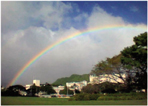|   Ansel Adams might not have used a camera phone to photograph "Moonrise, Hernandez," but I bet he would have loved to have one around when he was hanging out with Edward Weston . The value of a photograph taken with a camera phone does not lie in its photographic quality. The value lies in the sense of immediacy and the knowledge that you are able to captureand, indeed, share [Hack #77] a moment in time that would have been lost had your camera phone not been with you. Most of us who are not professional photographers do not carry cameras with us all the time. Many of us, however, take our mobile phones everywhere we go. We take photographs for their personal value. Photographs can let us relive a special moment time again and again. So, for many of us, the choice between a nonexistent six-megapixel image (because the digital SLR is home, safe and sound, in the file cabinet) and a small, slightly blurry picture from the camera phone is clear: pull out the camera phone! For example, I can show you the rainbow in Figure 7-1 only because I had a camera phone with me to capture it. Figure 7-1. Camera-phone picture of a rainbow 
7.2.1 How Photos from Camera Phones Are Different Anyone who has played with taking pictures on a camera phone knows that it's not the same as regular digital photography, at least not yet. We're already seeing impressive improvements in camera-phone technology in Japan, and those improvements will soon spread across the globe. Until then, here are some of the main reasons why photographs taken with camera phones don't look quite as good as those taken with regular digital cameras. -
- Pixel resolution
-
Many camera phones still take pictures at 640 480 pixel resolution (0.33 megapixels). In printing terms, these dimensions translate to output that is 3" 4", before cropping. We're starting to see more camera phones with higher megapixel resolution, so if making prints is important to you, look for that specification in your next phone. -
- Optical properties of the lens
-
The camera lens used in camera phones cannot be expected to compete with hobbyist, semiprofessional, or professional camera lenses. Moreover, if you look at a camera phone's lens, you will notice that it has some kind of plastic or other clear material to protect the lens. Although this protective covering generally appears transparent to your eye, it probably does not allow the perfect, unimpeded transmission of light through it to the camera lens. It is also susceptible to tiny scratches (or worse ) that might contribute to image blurring and chromatic (i.e., color ) aberration. -
- Image sensor properties
-
Instead of film, digital cameras have an image sensor. As you might imagine, the image sensors in camera phones generally do not have the same image-capturing quality found in conventional digital cameras, especially compared to new digital image-processing technologies such as Canon's DiGiC, Kyocera's RTUNE, and Olympus' TruePic, which are all sophisticated and greatly enhance signal processing. -
- Lack of automated image-enhancing features
-
Many conventional digital cameras have preset options that automate various camera-focusing and light-capturing characteristics. These preset options help you take clear photos of objects at various distances from you, under all kinds of lighting conditions. Camera phones have minimal, if any, such adjustments (either manual or automated). -
- No flash
-
A few camera phones have an integrated or add-on flash. Most, however, still do not. This makes it difficult to take photographs in dimly lit or backlit conditions. 7.2.2 Ways to Improve Your Camera-Phone Photographs The drawbacks should not discourage you from taking lots of photographs with your camera phone, though. There are several easy ways to improve the quality and enjoyment of your camera-phone photographs. -
- Take a lot of test photographs
-
As soon as you get your camera phone, learn about its photographic characteristics by taking plenty of pictures. How do its images look under different lighting conditions? How accurate is its color reproduction under different conditions? How close can you get to an object before the photo becomes blurry? -
- Accept that sub-megapixel images are small
-
Figure 7-2 shows a .33-megapixel (640 480) photograph taken with a Nokia 3650 camera phone, laid over a photograph taken with a 4-megapixel (2272 1704) Canon PowerShot G3. As you can see, there is a significant size difference between the camera phone image and the Canon picture. Figure 7-2. Size comparison of .33-megapixel and 4-megapixel images 
Learn to move closer to your subject before taking a photograph. Otherwise, you will have a tiny photograph with tiny, hard-to-see main objects. -
- Get a commercial or open source image-editing tool
-
A good image-editing tool will help you deal with some of the other issues discussed in this section. Throughout the book, we've been working with Photoshop, but alternatives, such as the open source GIMP image editor and the commercial JASC Paintshop Pro image editor, perform similar image-editing functions under Fedora Linux and Microsoft Windows XP, respectively. -
- Use unsharp mask
-
The Unsharp Mask filter [Hack #63] is available in many photo-editing applications. Camera-phone photographs tend to look like soft-focus (blurry) photographs. You will usually want to sharpen the image to improve its appearance. -
- Apply color balancing
-
The Color Balance feature of your image-editing application will adjust for the camera phone's color-reproduction characteristics. Once you figure out the general direction in which the color shifts for your particular camera phone, you can quickly make corrections in Photoshop or the image editor or your choice. -
- Adjust brightness and contrast
-
Camera-phone photographs are often under- or overexposed . Adjusting the brightness and contrast of your image can make it look more like what you recall seeing, or at least make it look more appealing. If your image-editing software has a Gamma Correction tool, such as Levels, you should learn to use it as an alternative to the Brightness tool because it enables you to adjust the midtones. Camera phones often have difficulty rendering midtones correctly. -
- Increase color saturation
-
Camera-phone photographs sometimes appear undersaturated (i.e., faded). The act of adjusting brightness can also reduce the perceived color saturation. Increasing color saturation can help make the photograph look closer to what you remember seeing when you took the photo. 7.2.3 The Techniques in Action Figure 7-3 shows an original camera-phone image, and Figure 7-4 illustrates how it can be improved with an image editor such as Photoshop Elements. The original photo was taken outdoors in a shaded area. Like many camera phones, the Nokia 3650 I used to take this photograph does not have a flash. So, I could not use a fill flash to deal with the lighting problem when the picture was taken. The other significant issue is the strong magenta tint that is especially noticeable in the exposed skin areas. I applied a number of corrective actions to restore the image to what I recall seeing in real life: -
- Unsharp Mask
-
Used to sharpen the image -
- Gamma Correction
-
Used to lighten the midrange values -
- Color Balance
-
Increased the green value to reduce the magenta tinge and increased red and yellow values to get the skin tone to look more accurate -
- Increase Contrast
-
Used to restore the contrast, which was reduced while applying the Gamma Correction -
- Noise Edge Preserving Smooth filter
-
Applied to reduce some of the blocky effect created by the Unsharp Mask Figure 7-3. Original photo, taken with a Nokia 3650 camera phone 
Figure 7-4. The same photo after image correction 
Most camera-phone photos do not require this many corrective steps. As you learn the kinds of photographs produced by your camera phone under different conditions, you'll start to develop a set of standard procedures to maximize your enjoyment of your photos while minimizing your postproduction time in front of the computer. Todd Ogasawara |



